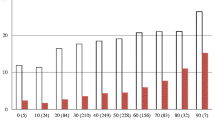Abstract
We analyze the contents of print ads in the motion picture industry (e.g., number of reviews quoted in the ad, the presence of a top reviewer, size of the ad, star, director, etc.). We find that external validation (a recommendation by a top reviewer) is more important to revenues than the informative content of the ad.
Similar content being viewed by others
References
Abernethy, A. M., & Franke, G. R. (1996). Information content of advertising: a meta-analysis. Journal of Advertising, 25(2), 1–17.
Anderson, S. P., & Renault, R. (2006). Advertising content. The American Economic Review, 96(1) March, 93–113.
Bagwell, K. (2007). The economic analysis of advertising. In M. Armstrong & R. Porter (Eds.), Handbook of industrial organization (Vol. 3, pp. 1701–1844). Amsterdam: North-Holland.
Basuroy, S., Chatterjee, S., & Ravid, S. (2003). How critical are critical reviews? The box office effects of film critics, star power, and budgets. Journal of Marketing, 67(October), 103–117.
Bertrand, M., Karlan, D., Mullainathan, S., Shafir, E., & Zinman, J. (2010). What’s advertising content worth? Evidence from a consumer credit marketing field experiment. Quarterly Journal of Economics, 125(1), 263–306.
Cameron, A. C., & Trivedi P. K.(2005), Microeconometrics: methods and applications. Cambridge University Press, UK.
Cameron, A. C., & Miller, D. L. (2011). Robust inference with clustered data. In A. Ullah & D. E. Giles (Eds.), Handbook of empirical economics and finance (pp. 1–28). Boca Raton: CRC Press.
Desai, K. K., & Basuroy, S. (2005). Interactive influences of genre familiarity, star power, and critics’ reviews in the cultural goods industry: the case of motion pictures. Psychology and Marketing, 22(3), 203–223.
DeVany, A., & Walls, D. (2002). Does Hollywood make too many R-rated movies? Risk, stochastic dominance, and the illusion of expectation. Journal of Business, 75(3), 425–451.
Elberse, A., & Eliashberg, J. (2003). Demand and supply dynamics behavior for sequentially released products in international markets: the case of motion pictures. Marketing Science, 22(3), 329–354.
Eliashberg, J., & Shugan, S. M. (1997). Film critics: influencers or predictors? Journal of Marketing, 61(April), 68–78.
Holbrook, M. B. (1999). Popular appeal versus expert judgements of motion pictures. Journal of Consumer Research, 26(September), 144–155.
Liu, Y. (2006). Word-of-mouth for movies: its dynamics and impact on box office revenue. Journal of Marketing, 70(3), 74–89.
Nevo, A. (2000). “A Practitioner's Guide to Estimation of Random Coe cients Logit Models of Demand,” Journal of Economics and Management Strategy, 9, 513–548.
Palia, D. S. Abraham Ravid and N. Reisel (2008), “Choosing to co-finance—an analysis of Project Specific Alliances in the film industry,” Review of Financial Studies, April ,483–511.
Ravid, S. A. (1999). Information, blockbusters, and stars: a study of the film industry. Journal of Business, 72(4) October, 463–492.
Ravid, S. A. & Basuroy S. (2004). “Managerial Objectives, the R-rating Puzzle, and the Production of Violent Films,” Journal of Business, 77(2), 155–192.
Rossi, P. E. (2014). “Invited Paper—Even the Rich Can Make Themselves Poor: A critical examination of IV methods in marketing applications,” Marketing Science, 33(5), 655–672.
Song, R., Jang, S., & Gangshu (George), C. (2016). Does advertising indicate product quality? Evidence from prelaunch and Postlaunch advertising in the movie industry. Marketing Letters, 27(4), 791–804.
Wooldridge, J. M. (2010). Econometric analysis of cross section and panel data (2nd ed.). MIT Press: Cambridge.
Wooldridge, J. M. (2003). Introductory econometrics: a modern approach (2nd ed.). Mason, USA: Thomson-Southwestern.
Acknowledgements
We thank participants in the UCLA Annual Business and Economics Scholars Workshop in Motion Picture Industry Studies, and participants in SERG (Screen Economics Research Group) conference in Sydney, Australia, for their comments. We thank Jura Liaukonyte for her careful reading of this manuscript and valuable suggestions.
Author information
Authors and Affiliations
Corresponding author
Appendix: How we code the ads.
Appendix: How we code the ads.

Rights and permissions
About this article
Cite this article
Rao, V.R., Abraham (Avri) Ravid, S., Gretz, R.T. et al. The impact of advertising content on movie revenues. Mark Lett 28, 341–355 (2017). https://doi.org/10.1007/s11002-017-9418-5
Published:
Issue Date:
DOI: https://doi.org/10.1007/s11002-017-9418-5




